Barriers to Telemedicine Adoption during the COVID-19 Pandemic in Taiwan: Comparison of Perceived Risks by Socioeconomic Status Correlates
Abstract
1. Introduction
2. Theoretical Model and Hypotheses
3. Materials and Methods
3.1. Reliability, Validity, and Bias
3.2. Model Fit
3.3. Hypothesis Testing and Group Comparison
4. Results
5. Discussion
6. Conclusions
6.1. Theoretical Contributions
6.2. Practical Implications
6.3. Limitations
Author Contributions
Funding
Institutional Review Board Statement
Informed Consent Statement
Data Availability Statement
Conflicts of Interest
References
- Chiesa, V.; Antony, G.; Wismar, M.; Rechel, B. COVID-19 Pandemic: Health Impact of Staying at Home, Social Distancing and “Lockdown” Measures—A Systematic Review of Systematic Reviews. J. Public Health 2021, 43, e462–e481. [Google Scholar] [CrossRef] [PubMed]
- West, D.M. How 5G Technology Enables the Health Internet of Things. Brook. Cent. Technol. Innov. 2016, 1, 20. [Google Scholar]
- Bakshi, S.; Tandon, U.; Mittal, A. Drivers and Barriers of Telemedicine in India: Seeking a New Paradigm. J. Comp. Theor. Nanosci. 2019, 16, 4367–4373. [Google Scholar] [CrossRef]
- Chen, T.-H.; Ma, C.-C.; Chiang, L.-L.; Ou, T.-C. Acceptance of Sustained Utilization Behavior of Telemedicine in the Post-COVID-19 Era. Appl. Ecol. Environ. Res. 2022, 20, 4633–4644. [Google Scholar] [CrossRef]
- Lee, P.-C.; Wang, J.T.-H.; Chen, T.-Y.; Peng, C.-H. Digital Healthcare in Taiwan: Innovations of National Health Insurance; Springer Nature: Cham, Switzerland, 2022. [Google Scholar] [CrossRef]
- AlQudah, A.A.; Al-Emran, M.; Shaalan, K. Technology Acceptance in Healthcare: A Systematic Review. Appl. Sci. 2021, 11, 10537. [Google Scholar] [CrossRef]
- Gupta, N.; Fischer, A.R.H.; Frewer, L.J. Socio-psychological Determinants of Public Acceptance of Technologies: A Review. Public Underst. Sci. 2012, 21, 782–795. [Google Scholar] [CrossRef]
- Wu, W.-Y.; Ke, C.-C. An Online Shopping Behavior Model Integrating Personality Traits, Perceived Risk, and Technology Acceptance. Soc. Behav. Pers. Int. J. 2015, 43, 85–97. [Google Scholar] [CrossRef]
- Lee, M.-C. Factors Influencing the Adoption of Internet Banking: An Integration of TAM and TPB With Perceived Risk and Perceived Benefit. Electron. Com. Res. Appl. 2009, 8, 130–141. [Google Scholar] [CrossRef]
- Liang, P.-H.; Chi, Y.-P. Influence of Perceived Risk of Blockchain Art Trading on User Attitude and Behavioral Intention. Sustainability 2021, 13, 13470. [Google Scholar] [CrossRef]
- Bakshi, S.; Tandon, U. Understanding Barriers of Telemedicine Adoption: A Study in North India. Syst. Res. Behav. Sci. 2022, 39, 128–142. [Google Scholar] [CrossRef]
- Swanson Kazley, A.; McLeod, A.C.; Wager, K.A. Telemedicine in an International Context: Definition, Use, and Future. Health Information Technology in the International Context. Adv. Health Care Manag. 2012, 12, 143–169. [Google Scholar]
- Vicente, M.A.; Fernández, C.; Guilabert, M.; Carrillo, I.; Martín-Delgado, J.; Mira, J.J.; Prometeo173 Working Group. Patient Engagement Using Telemedicine in Primary Care During COVID-19 Pandemic: A Trial Study. Int. J. Environ. Res. Public Health 2022, 19, 14682. [Google Scholar] [CrossRef] [PubMed]
- Eberly, L.A.; Kallan, M.J.; Julien, H.M.; Haynes, N.; Khatana, S.A.M.; Nathan, A.S.; Snider, C.; Chokshi, N.P.; Eneanya, N.D.; Takvorian, S.U.; et al. Patient Characteristics Associated With Telemedicine Access for Primary and Specialty Ambulatory Care During the COVID-19 Pandemic. JAMA Netw. Open 2020, 3, e2031640. [Google Scholar] [CrossRef] [PubMed]
- Su, Z.; Cheshmehzangi, A.; Bentley, B.L.; McDonnell, D.; Šegalo, S.; Ahmad, J.; Chen, H.; Terjesen, L.A.; Lopez, E.; Wagers, S.; et al. Technology-Based Interventions for Health Challenges Older Women Face Amid COVID-19: A Systematic Review Protocol. Syst. Rev. 2022, 11, 271. [Google Scholar] [CrossRef] [PubMed]
- Warshaw, P.R.; Davis, F.D. Disentangling Behavioral Intention and Behavioral Expectation. J. Exp. Soc. Psychol. 1985, 21, 213–228. [Google Scholar] [CrossRef]
- World Health Organization. Recommendations on Digital Interventions for Health System Strengthening; WHO Guideline; World Health Organization: Geneva, Switzerland, 2019. [Google Scholar]
- Liu, C.F. Key Factors Influencing the Intention of Telecare Adoption: An Institutional Perspective. Telemed. J. E Health 2011, 17, 288–293. [Google Scholar] [CrossRef]
- Bauer, R. Consumer Behavior as Risk Taking. In Risk Taking & Information Handling in Consumer Behavior; Cox, D.F., Ed.; Harvard University Press: Cambridge, MA, USA, 1960; pp. 389–398. [Google Scholar]
- Maziriri, E.T.; Chuchu, T. The Conception of Consumer Perceived Risk Towards Online Purchases of Apparel and an Idiosyncratic Scrutiny of Perceived Social Risk: A Review of Literature. Int. Rev. Manag. Mark. 2017, 7, 257–265. [Google Scholar]
- González Mieres, C.; María Díaz Martín, A.; Trespalacios Gutiérrez, J.A. Influence of Perceived Risk on Store Brand Proneness. Int. J. Retail Distrib. Manag. 2006, 34, 761–772. [Google Scholar] [CrossRef]
- Cunningham, S.M. The Major Dimensions of Perceived Risk. In Risk Taking & Information Handling in Consumer Behavior; Cox, D.F., Ed.; Harvard University Press: Boston, MA, USA, 1967. [Google Scholar]
- Rho, M.J.; Yoon, K.H.; Kim, H.; Choi, I.Y. Users’ Perception on Telemedicine Service: A Comparative Study of Public Healthcare and Private Healthcare. Multimedia Tool. Appl. 2015, 74, 2483–2497. [Google Scholar] [CrossRef]
- Tandon, U.; Kiran, R.; Sah, A.N. Understanding Barriers and Drivers to Online Shopping: An Emerging Economy Case. Int. J. Electron. Bus. 2017, 13, 216–243. [Google Scholar] [CrossRef]
- Featherman, M.S.; Hajli, N. Self-Service Technologies and e-Services Risks in Social Commerce Era. J. Bus. Ethics. 2016, 139, 251–269. [Google Scholar] [CrossRef]
- Bajowala, S.S.; Milosch, J.; Bansal, C. Telemedicine Pays: Billing and Coding Update. Curr. Allergy Asthma Rep. 2020, 20, 60. [Google Scholar] [CrossRef] [PubMed]
- Luo, X.; Li, H.; Zhang, J.; Shim, J.P. Examining Multi-dimensional Trust and Multi-faceted Risk in Initial Acceptance of Emerging Technologies: An Empirical Study of Mobile Banking Services. Decis. Support Syst. 2010, 49, 222–234. [Google Scholar] [CrossRef]
- Weißenfeld, M.M.; Goetz, K.; Steinhäuser, J. Facilitators and Barriers for the Implementation of Telemedicine From a Local Government Point of View-A Cross-Sectional Survey in Germany. BMC Health Serv. Res. 2021, 21, 919. [Google Scholar] [CrossRef] [PubMed]
- Isautier, J.M.J.; Copp, T.; Ayre, J.; Cvejic, E.; Meyerowitz-Katz, G.; Batcup, C.; Bonner, C.; Dodd, R.; Nickel, B.; Pickles, K.; et al. People’s Experiences and Satisfaction With Telehealth During the COVID-19 Pandemic in Australia: Cross-Sectional Survey Study. J. Med. Internet Res. 2020, 22, e24531. [Google Scholar] [CrossRef] [PubMed]
- Yang, Y.Q.; Liu, Y.; Li, H.; Yu, B. Understanding Perceived Risks in Mobile Payment Acceptance. Ind. Manag. Data Syst. 2015, 115, 253–269. [Google Scholar] [CrossRef]
- Tsai, T.H.; Lin, W.Y.; Chang, Y.S.; Chang, P.C.; Lee, M.Y. Technology Anxiety and Resistance to Change Behavioral Study of a Wearable Cardiac Warming System Using an Extended TAM for Older Adults. PLoS ONE 2020, 15, e0227270. [Google Scholar] [CrossRef]
- Kamal, S.A.; Shafiq, M.; Kakria, P. Investigating Acceptance of Telemedicine Services Through an Extended Technology Acceptance Model (TAM). Technol. Soc. 2020, 60, 101212. [Google Scholar] [CrossRef]
- AlQudah, A.A.; Al-Emran, M.; Daim, T.U.; Shaalan, K. Toward an Integrated Model for Examining the Factors Affecting the Acceptance of Queue Management Solutions in Healthcare. IEEE Trans. Eng. Manag. 2022, 1–17. [Google Scholar] [CrossRef]
- Benis, A.; Banker, M.; Pinkasovich, D.; Kirin, M.; Yoshai, B.E.; Benchoam-Ravid, R.; Ashkenazi, S.; Seidmann, A. Reasons for Utilizing Telemedicine During and After the COVID-19 Pandemic: An Internet-Based International Study. J. Clin. Med. 2021, 10, 5519. [Google Scholar] [CrossRef]
- Harst, L.; Lantzsch, H.; Scheibe, M. Theories Predicting End-User Acceptance of Telemedicine Use: Systematic Review. J. Med. Internet Res. 2019, 21, e13117. [Google Scholar] [CrossRef] [PubMed]
- Portnoy, J.; Waller, M.; Elliott, T. Telemedicine in the Era of COVID-19. J. Allergy Clin. Immunol. Pract. 2020, 8, 1489–1491. [Google Scholar] [CrossRef]
- Kato-Lin, Y.C.; Thelen, S.T. Privacy Concerns and Continued Use Intention of Telemedicine During COVID-19. Telemed. J. E Health 2022, 28, 1440–1448. [Google Scholar] [CrossRef] [PubMed]
- Topacan, U.; Basoglu, N.; Daim, T. Health Information Service Adoption: Case of Telemedicine. In Proceedings of the 42nd Hawaii International Conference on System Sciences, Big Island, HI, USA, 5–8 January 2009; Volume 2009. [Google Scholar]
- Iriani, S.S.; Andjarwati, A.L. Analysis of Perceived Usefulness, Perceived Ease of Use, and Perceived Risk Toward Online Shopping in the Era of COVID-19 Pandemic. Syst. Rev. Pharm. 2020, 11, 313–320. [Google Scholar]
- Featherman, M.S.; Pavlou, P.A. Predicting E-Services Adoption: A Perceived Risk Facets Perspective. Int. J. Hum. Comput. Stud. 2003, 59, 451–474. [Google Scholar] [CrossRef]
- Carroll, M.S.; Connaughton, D.P.; Spengler, J.O.; Byon, K.K. A Multidimensional Model of Perceived Risk in Spectator Sport. Int. J. Sport Manag. Mark. 2014, 24, 80–95. [Google Scholar]
- Cronbach, L.J. Coefficient Alpha and the Internal Structure of Tests. Psychometrika 1951, 16, 297–334. [Google Scholar] [CrossRef]
- Rigdon, E.E. Structural Equation Modeling: Nontraditional Alternatives. In Behavioral Science. Encyclopedia of Statistics; Brian, E., David, H., Eds.; Wiley: New York, NY, USA, 2005. [Google Scholar]
- Lowry, P.B.; Gaskin, J. Partial Least Squares (PLS) Structural Equation Modeling (SEM) for Building and Testing Behavioral Causal Theory: When to Choose It and How to Use It. IEEE Trans. Prof. Commun. 2014, 57, 123–146. [Google Scholar] [CrossRef]
- Carlson, K.D.; Herdman, A.O. Understanding the Impact of Convergent Validity on Research Results. Organ. Res. Methods 2010, 15, 17–32. [Google Scholar] [CrossRef]
- Chin, W.W. The Partial Least Squares Approach for Structural Equation Modeling. Modern Methods for Business Research. Methodol. Bus. Manag. 1998, 295, 295–336. [Google Scholar]
- Fornell, C.; Larcker, D.F. Structural Equation Models With Unobservable Variables and Measurement Error: Algebra and Statistics. J. Mark. Res. 1981, 18, 382–388. [Google Scholar] [CrossRef]
- Kock, N. Common Method Bias in PLS-SEM. Int. JE-Collab. 2015, 11, 1–10. [Google Scholar] [CrossRef]
- Hair, J.F.; Ringle, C.M.; Sarstedt, M. PLS-SEM: Indeed a Silver Bullet. J. Mark. Theor. Pract. 2011, 19, 139–152. [Google Scholar] [CrossRef]
- Hazra, A. Using the Confidence Interval Confidently. J. Thorac. Dis. 2017, 9, 4125–4130. [Google Scholar] [CrossRef] [PubMed]
- Elrod, J.K.; Fortenberry, J.L. Integrated Marketing Communications: A Strategic Priority in Health and Medicine. BMC Health Serv. Res. 2020, 20, 825. [Google Scholar] [CrossRef]
- Rad, P.M.; Chiang, D.; Connolly, J.; Mahmood, A. Distance Healthcare in Taiwan. J. Supply Chain Oper. Manag. 2022, 20, 75. [Google Scholar]
- Zeng, B.; Rivadeneira, N.A.; Wen, A.; Sarkar, U.; Khoong, E.C. The Impact of the COVID-19 Pandemic on Internet Use and the Use of Digital Health Tools: Secondary Analysis of the 2020 Health Information National Trends Survey. J. Med. Internet Res. 2022, 24, e35828. [Google Scholar] [CrossRef]
- Nouri, S.; Khoong, E.C.; Lyles, C.R.; Karliner, L. Addressing Equity in Telemedicine for Chronic Disease Management During the COVID-19 Pandemic. NEJM Catal Innov. Care Deliv. 2020, 1, 1–13. [Google Scholar]
- Scott Kruse, C.S.; Karem, P.; Shifflett, K.; Vegi, L.; Ravi, K.; Brooks, M. Evaluating Barriers to Adopting Telemedicine Worldwide: A Systematic Review. J. Telemed. Telecare 2018, 24, 4–12. [Google Scholar] [CrossRef]
- Guo, X.; Sun, Y.; Wang, N.; Peng, Z.; Yan, Z. The Dark Side of Elderly Acceptance of Preventive Mobile Health Services in China. Electron. Markets 2013, 23, 49–61. [Google Scholar] [CrossRef]
- Almousa, M. Perceived Risk in Apparel Online Shopping: A Multi Dimensional Perspective. Can. Soc. Sci. 2011, 7, 23–31. [Google Scholar]
- Eze, N.D.; Mateus, C.; Cravo Oliveira Hashiguchi, T.C.O. Telemedicine in the OECD: An Umbrella Review of Clinical and Cost-Effectiveness, Patient Experience and Implementation. PLoS ONE 2020, 15, e0237585. [Google Scholar] [CrossRef]
- Kontos, E.; Blake, K.D.; Chou, W.Y.; Prestin, A. Predictors of E-Health Usage: Insights on the Digital Divide From the Health Information National Trends Survey 2012. J. Med. Internet Res. 2014, 16, e172. [Google Scholar] [CrossRef] [PubMed]
- Al Meslamani, A.Z.; Aldulaymi, R.; El Sharu, H.; Alwarawrah, Z.; Ibrahim, O.M.; Al Mazrouei, N. The patterns and determinants of telemedicine use during the COVID-19 crisis: A nationwide study. J. Am. Pharm. Assoc. 2022, 62, 1778–1785. [Google Scholar] [CrossRef] [PubMed]
- Wu, T.C.; Ho, C.B. A Narrative Review of Innovative Responses During the COVID-19 Pandemic in 2020. Int. J. Public Health 2022, 67, 1604652. [Google Scholar] [CrossRef] [PubMed]
- Chang, J.E.; Lai, A.Y.; Gupta, A.; Nguyen, A.M.; Berry, C.A.; Shelley, D.R. Rapid Transition to Telehealth and the Digital Divide: Implications for Primary Care Access and Equity in a Post-COVID Era. Milbank Q. 2021, 99, 340–368. [Google Scholar] [CrossRef] [PubMed]
- Furlepa, K.; Tenderenda, A.; Kozłowski, R.; Marczak, M.; Wierzba, W.; Śliwczyński, A. Recommendations for the Development of Telemedicine in Poland Based on the Analysis of Barriers and Selected Telemedicine Solutions. Int. J. Environ. Res. Public Health 2022, 19, 1221. [Google Scholar] [CrossRef] [PubMed]
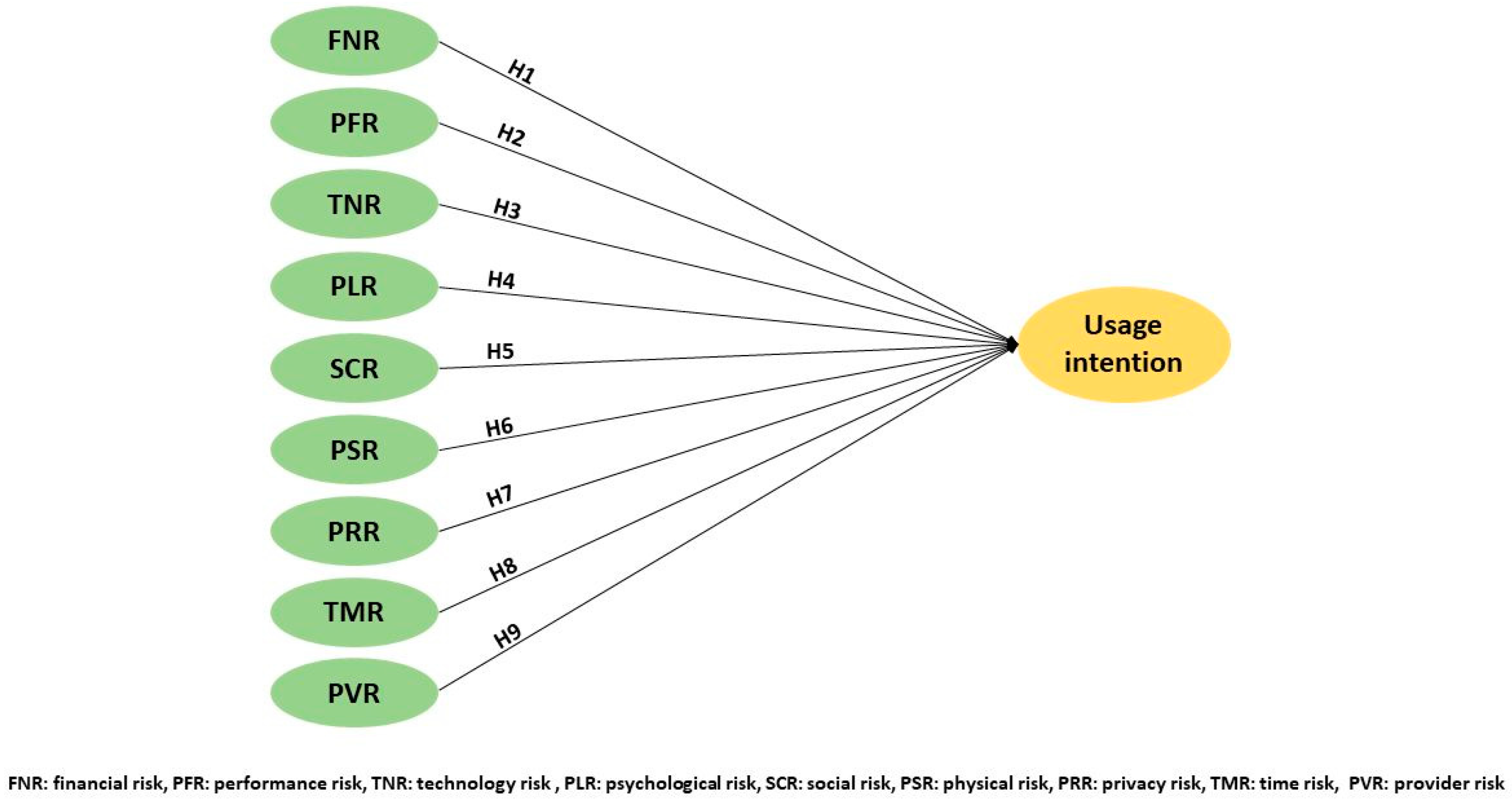

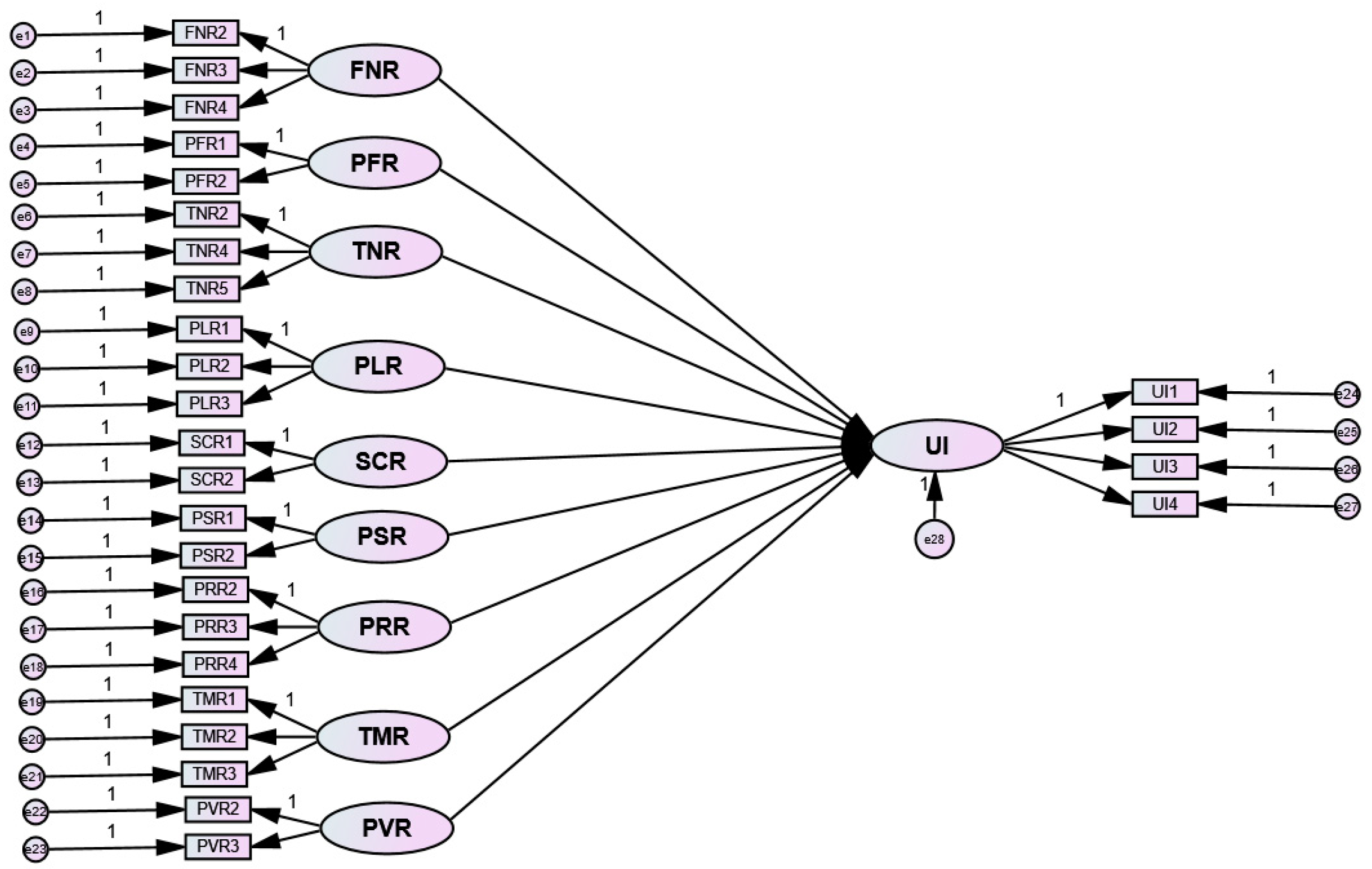
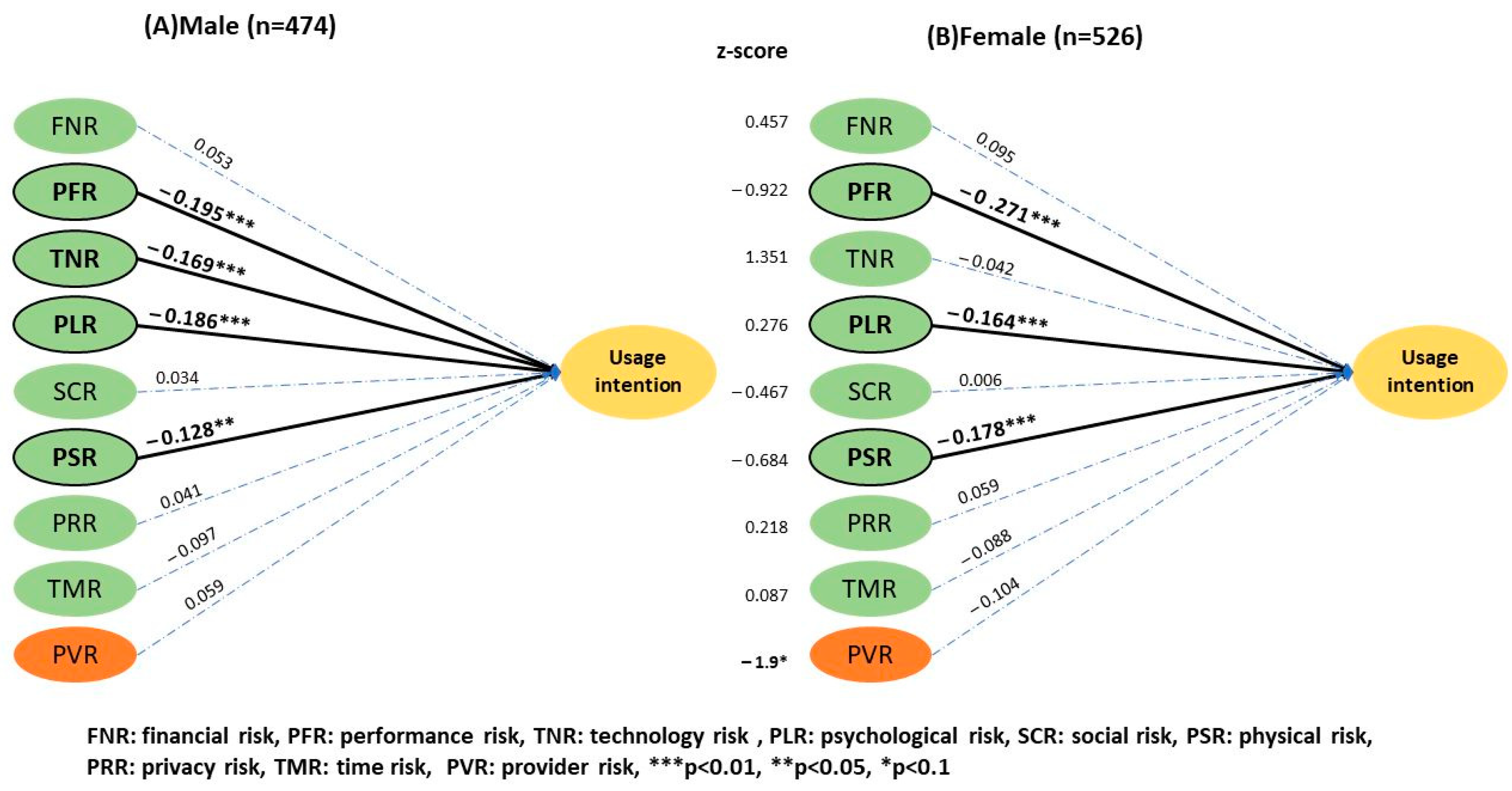

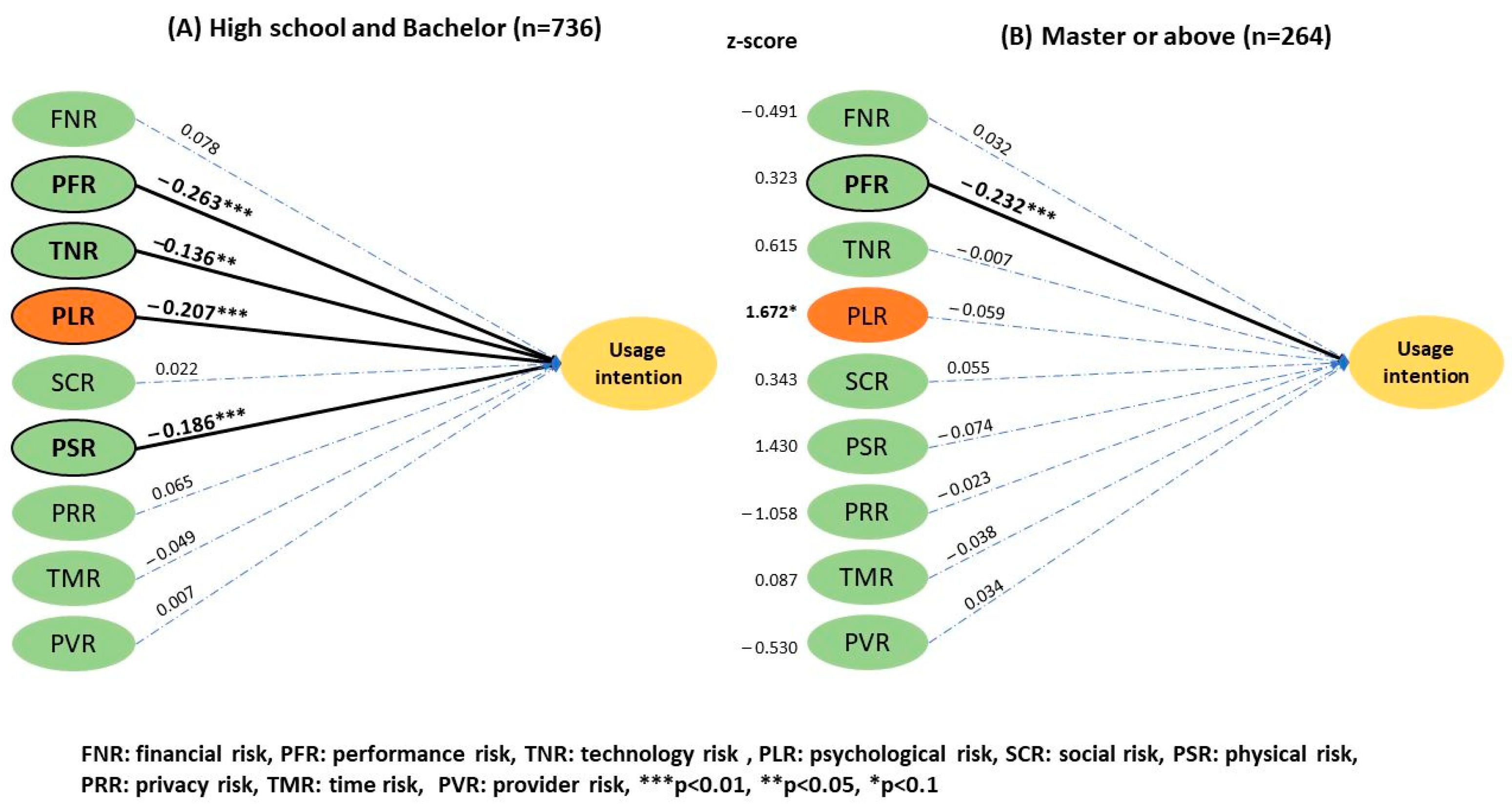
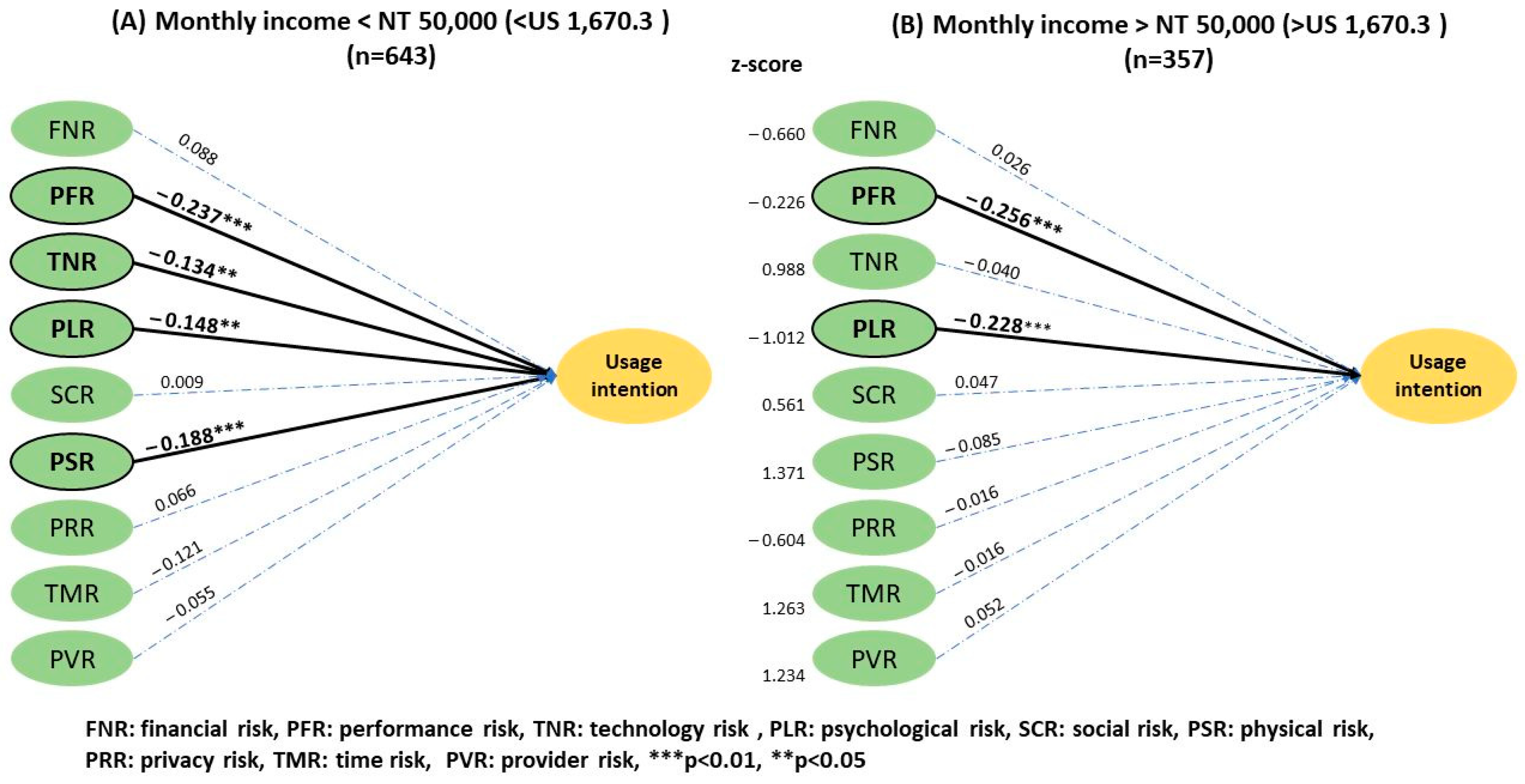

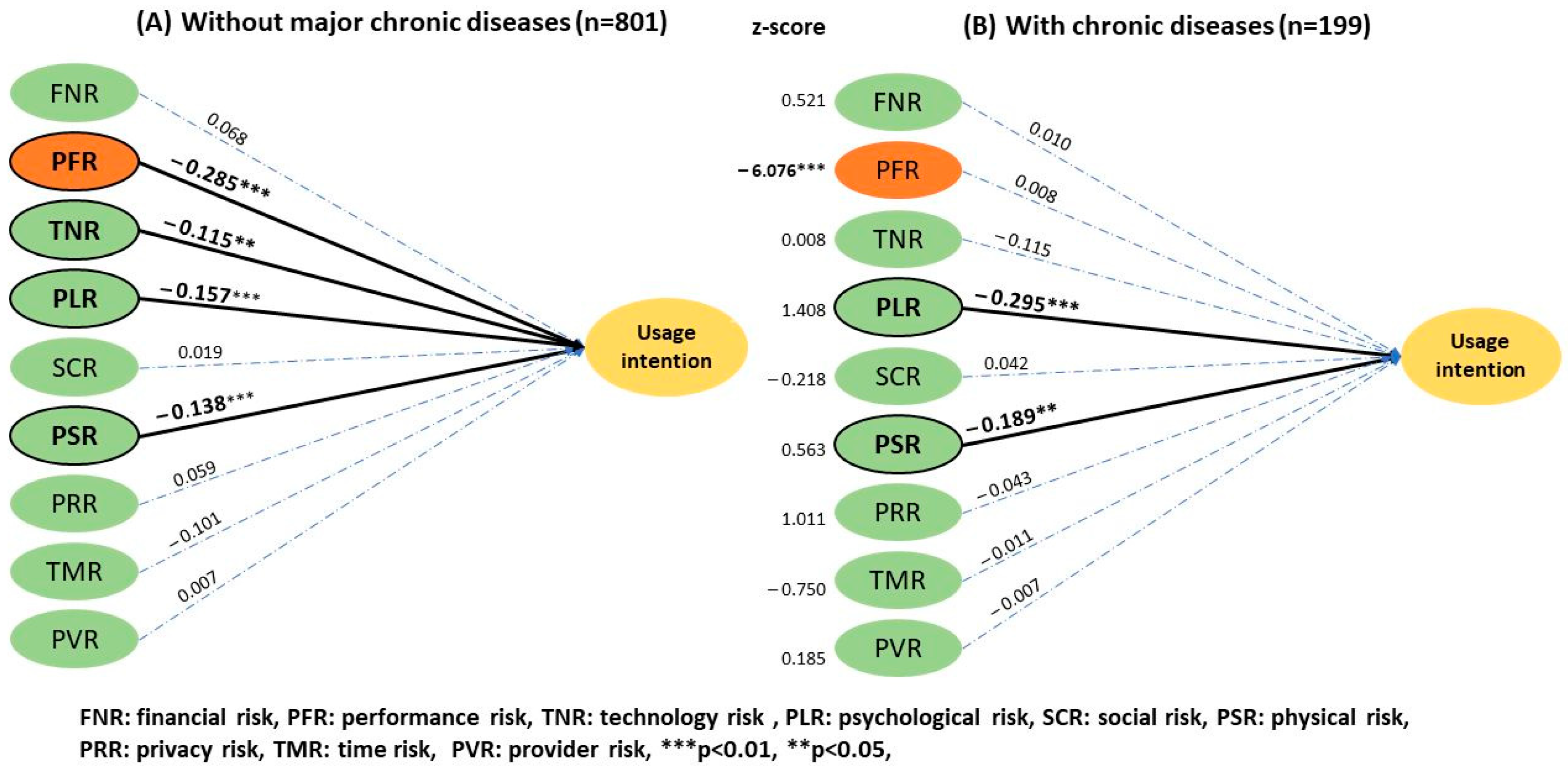
| Type of Perceived Risk | Description | |
|---|---|---|
| Financial risk | Risk of monetary loss or unexpected costs due to service and the maintenance costs of the product (such as mobile phone and Internet) | [11] |
| Performance risk | Risk of not performing as expected or failing to deliver the desired benefits | [40] |
| Technological risk | Risk of the user’s perceived uncertainty and apprehension (including use, process, and result) regarding the usage of the technology | [23] |
| Psychological risk | Risk of loss of self-esteem, ego frustration, and generated pressure and anxiety resulting from the service selection | [40] |
| Social risk | Reflects the disappointment or potential loss of status in the individual by people in surroundings, including friends and family, due to use of the service | [11,20] |
| Physical risk | Risk to the user’s safety or users fearing risk to their health resulting from the service use | [41] |
| Privacy risk | Risk of losing personal information and of the stealing of personal health information or data | [40] |
| Provider risk | Risk of the user’s perceived uncertainty about the service provider, including physicians, nurses, healthcare providers, and hospital | [23] |
| Time risk | Risk of time lost because of service failure or the service not meeting expectations | [11] |
| Characteristics | Number and Percentage | |
|---|---|---|
| Gender | Male | 474 (47.4%) |
| Female | 526 (52.6%) | |
| Age | <20 | 44 (4.4%) |
| 20–29 | 274 (27.4%) | |
| 30–39 | 169 (16.9%) | |
| 40–49 | 214 (21.4%) | |
| >50 | 299 (29.9%) | |
| Education level | High School | 129 (12.9%) |
| Bachelor’s | 607 (60.7%) | |
| Master’s | 241 (24.1%) | |
| Doctoral | 23 (2.3%) | |
| Monthly income in NT$ (US$) | <30,000 (<1002.2) | 288 (28.8%) |
| 30,000–50,000 (1002.2–1670.3) | 355 (35.5%) | |
| 50,000–100,000 (1670.3–3340.7) | 250 (25%) | |
| >100,000 (>3340.7) | 107 (10.7%) | |
| Residence | Northern Taiwan | 344 (34.4%) |
| Central Taiwan | 432 (43.2%) | |
| Southern Taiwan | 191 (19.1%) | |
| Eastern Taiwan | 33 (3.3%) | |
| Experience with telemedicine | None | 839 (83.9%) |
| 1–3 times | 147 (14.7%) | |
| >3 times | 14 (1.4%) | |
| History of chronic disease | None | 801 (80.1%) |
| Yes | 199 (19.9%) | |
| Items | Std. Loading | Mean | SD | AVE | CR | * α | |
|---|---|---|---|---|---|---|---|
| Financial risk (FNR) | FNR2 | 0.72 | 3.33 | 0.854 | 0.585 | 0.809 | 0.807 |
| FNR3 | 0.77 | ||||||
| FNR4 | 0.79 | ||||||
| Performance risk (PFR) | PFR1 | 0.86 | 3.40 | 0.878 | 0.770 | 0.870 | 0.870 |
| PFR2 | 0.90 | ||||||
| Technology risk (TNR) | TNR2 | 0.78 | 3.45 | 0.898 | 0.595 | 0.815 | 0.812 |
| TNR4 | 0.81 | ||||||
| TNR5 | 0.72 | ||||||
| Psychological risk (PLR) | PLR1 | 0.87 | 2.73 | 0.897 | 0.715 | 0.882 | 0.877 |
| PLR2 | 0.88 | ||||||
| PLR3 | 0.78 | ||||||
| Social Risk (SCR) | SCR1 | 0.90 | 2.09 | 0.811 | 0.778 | 0.875 | 0.874 |
| SCR2 | 0.86 | ||||||
| Physical risk (PSR) | PSR1 | 0.85 | 2.49 | 0.897 | 0.758 | 0.862 | 0.859 |
| PSR2 | 0.89 | ||||||
| Privacy risk (PRR) | PRR2 | 0.81 | 3.42 | 0.967 | 0.782 | 0.915 | 0.912 |
| PRR3 | 0.93 | ||||||
| PRR4 | 0.90 | ||||||
| Time risk (TMR) | TMR1 | 0.54 | 3.37 | 0.831 | 0.506 | 0.750 | 0.745 |
| TMR2 | 0.75 | ||||||
| TMR3 | 0.79 | ||||||
| Provider risk (PVR) | PVR2 | 0.79 | 3.43 | 0.977 | 0.736 | 0.847 | 0.840 |
| PVR3 | 0.79 | ||||||
| Usage Intention (UI) | UI1 | 0.86 | 3.87 | 0.768 | 0.655 | 0.883 | 0.882 |
| UI2 | 0.82 | ||||||
| UI3 | 0.73 | ||||||
| UI4 | 0.82 | ||||||
| 1 | 2 | 3 | 4 | 5 | 6 | 7 | 8 | 9 | 10 | |
|---|---|---|---|---|---|---|---|---|---|---|
| 1. FNR | 0.765 | |||||||||
| 2. PFR | 0.467 | 0.878 | ||||||||
| 3. TNR | 0.532 | 0.679 | 0.772 | |||||||
| 4. PLR | 0.459 | 0.528 | 0.562 | 0.845 | ||||||
| 5. SCR | 0.365 | 0.250 | 0.327 | 0.699 | 0.882 | |||||
| 6. PSR | 0.392 | 0.387 | 0.436 | 0.563 | 0.583 | 0.871 | ||||
| 7. PRR | 0.562 | 0.506 | 0.636 | 0.463 | 0.326 | 0.429 | 0.884 | |||
| 8. TMR | 0.651 | 0.655 | 0.668 | 0.425 | 0.208 | 0.314 | 0.531 | 0.712 | ||
| 9. PVR | 0.596 | 0.534 | 0.713 | 0.483 | 0.302 | 0.403 | 0.763 | 0.541 | 0.858 | |
| 10. UI | −0.217 | −0.447 | −0.390 | −0.399 | −0.225 | −0.349 | −0.248 | −0.311 | −0.279 | 0.809 |
| Fit Measure | Measurement Model | Recommended Values |
|---|---|---|
| Chi-square | 816 | - |
| Degree of freedom | 279 | - |
| χ2/df | 2.92 | <3 |
| GFI | 0.941 | >0.9 |
| CFI | 0.968 | >0.9 |
| RMSEA | 0.044 | <0.08 |
| Hypothesis (H) | Factor Loading | Standard Error | CR | p Valve | Result | |
|---|---|---|---|---|---|---|
| H1: | UI<-FNR | 0.064 | 0.045 | 1.42 | 0.156 | Rejected |
| H2: | UI<-PFR | −0.242 | 0.041 | −5.96 | *** | Accepted |
| H3: | UI<-TNR | −0.116 | 0.046 | −2.53 | 0.011 | Accepted |
| H4: | UI<-PLR | −0.168 | 0.039 | −4.29 | *** | Accepted |
| H5: | UI<-SCR | 0.016 | 0.036 | 0.44 | 0.654 | Rejected |
| H6: | UI<-PSR | −0.150 | 0.036 | −4.16 | *** | Accepted |
| H7: | UI<-PRR | 0.040 | 0.036 | 1.11 | 0.267 | Rejected |
| H8: | UI<-TMR | −0.070 | 0.055 | −1.27 | 0.203 | Rejected |
| H9: | UI<-PVR | 0.005 | 0.005 | 0.97 | 0.331 | Rejected |
Disclaimer/Publisher’s Note: The statements, opinions and data contained in all publications are solely those of the individual author(s) and contributor(s) and not of MDPI and/or the editor(s). MDPI and/or the editor(s) disclaim responsibility for any injury to people or property resulting from any ideas, methods, instructions or products referred to in the content. |
© 2023 by the authors. Licensee MDPI, Basel, Switzerland. This article is an open access article distributed under the terms and conditions of the Creative Commons Attribution (CC BY) license (https://creativecommons.org/licenses/by/4.0/).
Share and Cite
Wu, T.-C.; Ho, C.-T.B. Barriers to Telemedicine Adoption during the COVID-19 Pandemic in Taiwan: Comparison of Perceived Risks by Socioeconomic Status Correlates. Int. J. Environ. Res. Public Health 2023, 20, 3504. https://doi.org/10.3390/ijerph20043504
Wu T-C, Ho C-TB. Barriers to Telemedicine Adoption during the COVID-19 Pandemic in Taiwan: Comparison of Perceived Risks by Socioeconomic Status Correlates. International Journal of Environmental Research and Public Health. 2023; 20(4):3504. https://doi.org/10.3390/ijerph20043504
Chicago/Turabian StyleWu, Tzu-Chi, and Chien-Ta Bruce Ho. 2023. "Barriers to Telemedicine Adoption during the COVID-19 Pandemic in Taiwan: Comparison of Perceived Risks by Socioeconomic Status Correlates" International Journal of Environmental Research and Public Health 20, no. 4: 3504. https://doi.org/10.3390/ijerph20043504
APA StyleWu, T.-C., & Ho, C.-T. B. (2023). Barriers to Telemedicine Adoption during the COVID-19 Pandemic in Taiwan: Comparison of Perceived Risks by Socioeconomic Status Correlates. International Journal of Environmental Research and Public Health, 20(4), 3504. https://doi.org/10.3390/ijerph20043504






